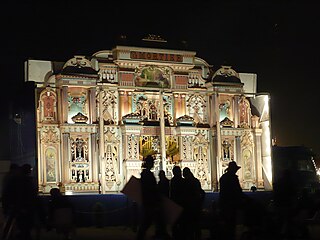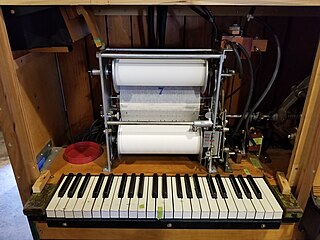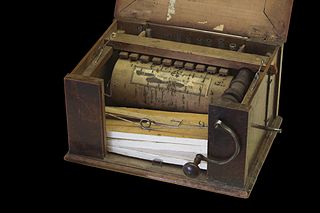 W
WAmerican Piano Company (Ampico) was an American piano manufacturer located in East Rochester, New York, The company In 1908 bought the William Knabe Co. Of Baltimore to add to their roster of fine piano companies. They had already bought Chickering Piano of Boston as well as Haines Brothers, Marshall & Wendell, and Foster, Armstrong & Company, all of East Rochester, New York. They later purchased the Mason and Hamlin piano company as their flagship piano.
 W
WA barrel organ is a mechanical musical instrument consisting of bellows and one or more ranks of pipes housed in a case, usually of wood, and often highly decorated. The basic principle is the same as a traditional pipe organ, but rather than being played by an organist, the barrel organ is activated either by a person turning a crank, or by clockwork driven by weights or springs. The pieces of music are encoded onto wooden barrels, which are analogous to the keyboard of the traditional pipe organ. A person which plays a barrel organ is known as an organ grinder.
 W
WA barrel piano is a forerunner of the modern player piano. Unlike the pneumatic player piano, a barrel piano is usually powered by turning a hand crank, though coin-operated models powered by clockwork were used to provide music in establishments such as pubs and cafés. Barrel pianos were popular with street musicians, who sought novel instruments that were also highly portable. They are frequently confused with barrel organs, but are quite different instruments.
 W
WBook music is a medium for storing the music played on mechanical organs, mainly of European manufacture. Book music is made from thick cardboard, containing perforated holes specifying the musical notes to be played, with the book folded zig-zag style. Unlike the heavy pinned barrels, which could only contain a few tunes of fixed length, that had been used on earlier instruments, book music enabled large repertoires to be built up. The length of each tune was no longer determined by the physical dimensions of the instrument.
 W
WA musical box is an automatic musical instrument in a box that produces musical notes by using a set of pins placed on a revolving cylinder or disc to pluck the tuned teeth of a steel comb. The earliest known mechanical musical instruments date back to 9th-century Baghdad. In Flanders, in the early 13th century, a bell ringer invented a cylinder with pins which operate cams, which then hit the bells. The popular device best known today as a "music box" developed from musical snuff boxes of the 18th century and were originally called carillons à musique. Some of the more complex boxes also contain a tiny drum and/or bells in addition to the metal comb.
 W
WA carillon is an idiophone percussion instrument that is played with a keyboard and consists of at least 23 cast bronze bells in fixed suspension and tuned in chromatic order so that they can be sounded harmoniously together. Usually housed in a bell tower, the bells are struck with clappers, which are connected to a keyboard of wooden batons played with the hands and pedals played with the feet. Often, carillons include an automatic system through which the time is announced and simple tunes are played.
 W
WThe componium is a mechanical musical instrument constructed in 1821 by Dietrich Nikolaus Winkel that composes novel music. It is an automatic organ consisting of two barrels that revolve simultaneously. The barrels take turns performing two measures of randomly chosen music while the other, silent, slides horizontally to select the next variation. A roulette-like flywheel chooses whether or not the next variation is selected. The instrument plays an 80 measure piece, with eight variations for every two measures.
 W
WA dance organ is a mechanical organ designed to be used in a dance hall or ballroom. Being intended for use indoors, dance organs tend to be quieter than the similar fairground organ.
 W
WDisklavier is the brand name for a family of high-tech reproducing pianos made by Yamaha Corporation. The first Disklavier was introduced in the United States in 1987.
 W
WDuo-Art was one of the leading reproducing piano technologies of the early 20th century, the others being American Piano Company (Ampico), introduced in 1913 too, and Welte-Mignon in 1905. These technologies flourished at that time because of the poor quality of the early Phonograph. Between 1913 and 1925 a number of distinguished classical and popular pianists, such as Ignace Paderewski, Josef Hofmann, Percy Grainger, Teresa Carreño, Aurelio Giorni, Robert Armbruster and Vladimir Horowitz, recorded for Duo-Art, and their rolls are a legacy of 19th-century and early 20th-century aesthetic and musical practice. The recording process – using a piano wired to a perforating machine – was unable to capture the pianist's dynamics automatically. These were added by a recording technician, who manipulated hand controls to notate the dynamics onto the recording 'master'. Thus, post-recording editing was required to produce the finished performance – usually a joint effort by the recording technician and the pianist themself, who approved the final product. Thus, these recordings do represent the overall style of these great artists and are a good representation of their live performances.
 W
WA fairground organ is a pneumatic musical organ covering the wind and percussive sections of an orchestra. Designed for use in a commercial public fairground setting to provide loud music to accompany fairground rides and attractions, mostly used on merry-go-rounds. Unlike organs intended for indoor use, they are designed to produce a large volume of sound to be heard over and above the noise of crowds of people and fairground machinery.
 W
WA music roll is a storage medium used to operate a mechanical musical instrument. They are used for the player piano, mechanical organ, electronic carillon and various types of orchestrion. The vast majority of music rolls are made of paper. Other materials that have been utilized include thin card (Imhof-system), thin sheet brass (Telektra-system), composite multi-layered electro-conductive aluminium and paper roll (Triste-system) and, in the modern era, thin plastic or PET film.
 W
WA musical clock is a clock that marks the hours of the day with a musical tune. They can be considered elaborate versions of striking or chiming clocks.
 W
WOrchestrion is a generic name for a machine that plays music and is designed to sound like an orchestra or band. Orchestrions may be operated by means of a large pinned cylinder or by a music roll and less commonly book music. The sound is usually produced by pipes, though they will be voiced differently from those found in a pipe organ, as well as percussion instruments. Many orchestrions contain a piano as well.
 W
WThe Panharmonicon was a musical instrument invented in 1805 by Johann Nepomuk Mälzel, a contemporary and friend of Beethoven. Beethoven apparently composed his piece "Wellington's Victory" to be played on this behemoth mechanical orchestral organ to commemorate Arthur Wellesley's victory over the French at the Battle of Vitoria in 1813. It was one of the first automatic playing machines, similar to the later Orchestrion.
 W
WA piano roll is a music storage medium used to operate a player piano, piano player or reproducing piano. Piano rolls, like other music rolls, are continuous rolls of paper with perforations (holes) punched into them. The perforations represent note control data. The roll moves over a reading system known as a 'tracker bar' and the playing cycle for each musical note is triggered when a perforation crosses the bar and is read.
 W
WA player piano is a self-playing piano, containing a pneumatic or electro-mechanical mechanism that operates the piano action via programmed music recorded on perforated paper, or in rare instances, metallic rolls, with more modern implementations using MIDI. The rise of the player piano grew with the rise of the mass-produced piano for the home in the late 19th and early 20th century. Sales peaked in 1924, then declined as the improvement in phonograph recordings due to electrical recording methods developed in the mid-1920s. The advent of electrical amplification in home music reproduction via radio in the same period helped cause their eventual decline in popularity, and the stock market crash of 1929 virtually wiped out production.
 W
WA player piano is a self-playing piano, containing a pneumatic or electro-mechanical mechanism that operates the piano action via programmed music recorded on perforated paper, or in rare instances, metallic rolls, with more modern implementations using MIDI. The rise of the player piano grew with the rise of the mass-produced piano for the home in the late 19th and early 20th century. Sales peaked in 1924, then declined as the improvement in phonograph recordings due to electrical recording methods developed in the mid-1920s. The advent of electrical amplification in home music reproduction via radio in the same period helped cause their eventual decline in popularity, and the stock market crash of 1929 virtually wiped out production.
 W
WPolyphon is a disc-playing music box, a mechanical device first manufactured by the Polyphon Musikwerke, located in Leipzig, Germany. Invented in 1870, full-scale production started around 1897 and continued into the early 1900s. Polyphons were exported all over world and music was supplied for the English, French and German markets, as well as further afield, with music cataloged for the Russian, Polish and Balkan regions. Polyphon is also a record label as registered by German Polyphon Musikwerke AG in 1908. Polyphon traded under the Polydor label since 1913 with their trademarks Polyphon Musik and Polyphon Record.
 W
WThe Regina Company was a manufacturer of mechanical musical instruments before it became a major vacuum maker.
 W
WThe Savart wheel is an acoustical device named after the French physicist Félix Savart (1791–1841), which was originally conceived and developed by the English scientist Robert Hooke (1635–1703).
 W
WA serinette is a type of mechanical musical instrument consisting of a small barrel organ. It appeared in the first half of the 18th century in eastern France, and was used to teach tunes to canaries. Its name is derived from the French serin, meaning “canary.”
 W
WA street organ played by an organ grinder is an automatic mechanical pneumatic organ designed to be mobile enough to play its music in the street. The two most commonly seen types are the smaller German and the larger Dutch street organ.
 W
WM. Welte & Sons, Freiburg and New York was a manufacturer of orchestrions, organs and reproducing pianos, established in Vöhrenbach by Michael Welte (1807–1880) in 1832.